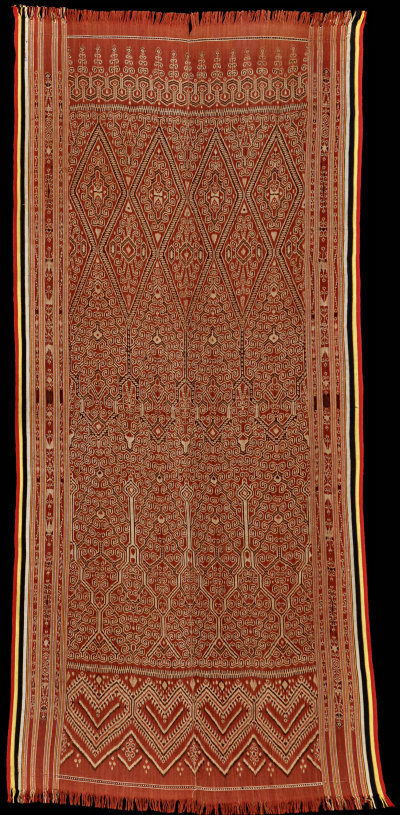| |
 
 | | | |
036 Borneo, Sarawak
Pua kumbu  
| | Locale: | Dayak, Saribas Iban. | | Period: | 1930-1945 | | Yarn: | Cotton, hand-spun, fine | | Technique: | Warp ikat | | Panels: | 2 | | Size: | 92 x 210 cm (3' 0" x 6' 10") LW: 2.28 | | Weight: | 475 g (16.8 oz), 246 g/m2 (0.81 oz/ft2) | | Design: | Ranyai motif, 'Tree of Life'. The pattern is of great refinement and intricacy. One end flares out considerably - an effect that came into fashion in the 1930s. Interesting use of the snake-like zigzag at the top end of the Tree of Life. Normally, snakes (representing deities and mythical heroes) are positioned at the base of the Tree, but in this instance, the weaver has positioned snakes at the top of the tree while giving them great prominence (one-third of the design is apportioned to it). The weaver obviously wanted to draw attention to the snakes; the reason for which she took with her to the grave. | | Comment: | Fine and tight weaving of the intricate design with 4-fold repeat per panel (3-fold repeats being far more common), deeply saturated colours, panels well aligned. About ten minute old repairs, not exceeding a few millimeters each. Otherwise in excellent condition with vivid colours. Flaring, nearly always at the bottom rather than the top, is achieved through a deliberate manipulation of the tension on the back-strap loom when putting weft to warp. Borders partly in toko thread. | | Background: | Chapters on Borneo and Sarawak. | | Exhibited: | Hong Kong University Museum and Art Gallery, 2017. | | Published: | Ikat Textiles of the Indonesian Archipelago, 2018.
| | Compare: | 034 035 037 | | Sources: | Identification of pattern and information on flaring by Vernon Kedit, pers. comm., 2017. Similar pua in Gittinger, Splendid Symbols, Fig. 168; Khan Majlis, Indonesische Textilien, Wege zu Goettern und Ahnen, Fig. 682 and p.174/175. See also Gavin, The Women's Warpath, Fig. 96, where pattern, is identied as 'honey bear pattern'. | | |

©Peter ten Hoopen, 2025
All rights reserved.
|
|


